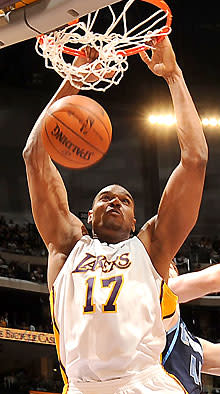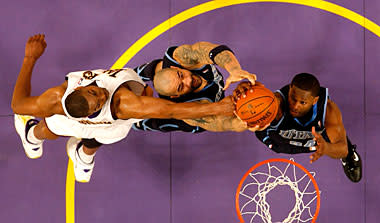Knee injury limits Lakers' Bynum
LOS ANGELES – Andrew Bynum(notes) planted hard with both feet and rose for what usually would be an easy two-handed slam. But with his sore right knee throbbing, the Los Angeles Lakers' 7-foot center felt like he had a “flat tire” as he barely lifted the basketball over the rim. As Bynum jogged down the floor gingerly, his knee covered by a bulky black brace, he looked like he was running in sand.
Bynum has been riddled by knee injuries for three straight seasons, and the latest has again come at an inopportune time, a small tear in his right meniscus that he suffered last Friday. Despite the injury, he gutted out 8 points and 10 rebounds in just 24 minutes after being listed as questionable entering the Lakers’ 104-99 Game 1 victory over the Utah Jazz in the Western Conference semifinals at Staples Center.
While Bynum has been told minor arthroscopic surgery could sideline him for about “one or two weeks,” he has opted to gut it out the rest of the way in the Lakers’ potentially long quest to repeat as champions.
“It’s there every step,” Bynum said about the knee pain. “But I think its something that I can go through to the end of this year. Landing and pushing off are the worst two [things]. But that’s normal with my injury. I just have to be aware of it and be careful when I come down and stuff like that.”
Throughout his five-year NBA career, Bynum has faced a bigger challenge overcoming injuries than opposing centers. He suffered a partially dislocated knee two seasons ago as the Lakers advanced to the NBA Finals. The following season, he tore the medial collateral ligament in his right knee. While Bynum did play in the postseason as the Lakers won the championship, he wasn’t at full strength while averaging 6.3 points and 3.7 rebounds.
“The injuries he’s had were based on impact from the side,” Lakers general manager Mitch Kupchak said. “The other one he was falling backwards. They are kind of freakish things. It’s not like he was running up and down the court. I know he’s a little frustrated from time to time. He wants to play a full season, make a contribution. We’re hoping he can do that this year.”
Bynum missed the last 13 games of this season with a strained Achilles tendon, but returned for the playoffs. His latest injury was suffered when he hyper-extended his right knee in the first half of the Lakers’ first-round clinching victory at Oklahoma City. After meeting with two doctors, he said he was told he had a partial tear, couldn’t damage it further by playing and the pain could potentially increase as time passes.
Considering how bad the other knee injuries were, Bynum actually considered this a breath of fresh air.
“I’ve had so many,” Bynum said. “The first one is the worst one. The second one it’s like, are you serious? The third one, I’m used to it. You just go through it.”
Said Kupchak: “Apparently, it’s something he can play with. I know he has some discomfort. But this is his fifth season and he’s a gamer. He understands that this is the time of year where you play. Now, my understanding is the injury is such that he has some discomfort he can play on. And then it gets to the point where you have too much discomfort, you don’t play.
“So we’re not that concerned about it developing into something bigger than it is today. We’re just hoping that game to game he can continue to make a contribution. I thought he did today.”
Portland Trail Blazers guard Brandon Roy(notes) returned to action just eight days from having right knee arthroscopic surgery, but he was far from full strength and his team was eventually eliminated in the first round. Bynum believes he could be out for two weeks if he has the surgery now, which could mean this series and part of the next round if the Lakers advance. The Lakers could probably win without Bynum if he opted for surgery against the undersized Jazz, who is without injured starting center Mehmet Okur(notes).
But while surgery is possible for Bynum at season’s end, he’d prefer to play with pain now and figure out the rest later.
“Even the surgery for this, if it gets to that point, I think most people come back in one or two weeks,” Bynum said. “Jordan [Farmar] had it. …He had the exact same thing I had and looked great. Brandon Roy, too. He came back in seven days.”
So why not have surgery?
“Because … I don’t know. I’m just good. I’m going to ride it until I need to have it. I don’t need it now. I’d rather play like this now,” Bynum said.
Bynum was still able to score in the post whether it was a hook shot or dunk and he actually seemed to move better in the second half. But he didn’t get to the free-throw line, lumbered up the floor on offense so slow he barely passed half court on fast breaks, didn’t block any shots and couldn’t take advantage of his 280-pound frame to block out. The Bynum the Lakers displayed Sunday was effective, but not as effective as he can be when healthy.
While Kobe Bryant(notes) used to be hard on Bynum for not quickly reaching his potential, he was proud of him Sunday for his display of toughness.
“He is doing a great job,” Bryant said. “He’s playing through an injury. Sometimes you have to do that. I think it shows maturity for the young player to start figuring out how to play around that and do different things to be effective despite the injury. That’s how you grow.”
It’s one thing to play on one leg against the Jazz’s young centers, Kyrylo Fesenko(notes) and Kosta Koufos(notes). But with each passing game and a possible tougher opponent looming in the West finals, Bynum’s knee injury will be challenged.
Could a slowed Bynum chase Phoenix’s Channing Frye(notes) to the 3-point line or guard athletic forward Amar’e Stoudemire(notes) in the post? The Spurs have size in Tim Duncan(notes), Antonio McDyess(notes) and DeJuan Blair(notes) that certainly could challenge Bynum. And if the Lakers get to the NBA Finals, Cleveland, Orlando and Boston all have big men that will be itching to exploit him.
As respectable as Bynum's toughness is, not having him will make the Lakers' quest to repeat even more difficult.
“I don’t think it can hurt more, at least I hope not,” Bynum said. “Anything is possible.”



